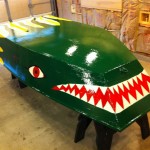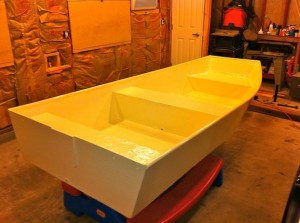
Painting continues on the HMS Sharktypus. It is now a terrifying specter with a gaping maw and unholy tentacles. Soon it will be the undisputed master of the sea. DO DOODLY DO!
See the latest photos.

On Land, At Sea, In The Air, In Space

Painting continues on the HMS Sharktypus. It is now a terrifying specter with a gaping maw and unholy tentacles. Soon it will be the undisputed master of the sea. DO DOODLY DO!
See the latest photos.
 The HMS Sharktypus, principal research dingy of the Bacliff Exploration Society, is primed and ready to receive its Sharktypus paint job. The finest European paints and honey badger hair paint brushes will be used for this project. It is hoped that the paint will significantly improve the vessel’s structural integrity.
The HMS Sharktypus, principal research dingy of the Bacliff Exploration Society, is primed and ready to receive its Sharktypus paint job. The finest European paints and honey badger hair paint brushes will be used for this project. It is hoped that the paint will significantly improve the vessel’s structural integrity.
 The Bacliff Exploration Society is embarking on an epic experiment. The goal: to start with a pair of pants, and (by bartering, trading, and/or stealing) to end up with a moose head (or a narwhal tusk, or stuffed polar bear or penguin). Follow this grand adventure at: Pants to Moose Head.
The Bacliff Exploration Society is embarking on an epic experiment. The goal: to start with a pair of pants, and (by bartering, trading, and/or stealing) to end up with a moose head (or a narwhal tusk, or stuffed polar bear or penguin). Follow this grand adventure at: Pants to Moose Head.
League City, TX
A combined buoyancy and beacon test of the Neritic Sounding Probe (NSP) was deemed a failure after the primary battery developed a short during transport to the test facility located at Watergate Yachting Center.
Arrival inspection revealed that the battery compartment had melted into a sort of U shape and was hot to the touch. It was decided to quick-deploy the probe into the test tank (Clear Lake) to limit the thermal excursion while the tool bag was located and brought on line. It was noted at this time that the NSP just barely floated without the full electronics payload. It would unquestionably sink without additional buoyancy.
The Channel Locks were utilized by support personnel to gain access to the battery compartment and release the 10 D-cell batteries into the safety inspection area (grass near end of Pier-6) No fire was observed at this time. The batteries were then allowed to naturally cool in situ.
An incident investigation board was quickly convened consisting of K. Sullivan, S. Stewart, T. Campbell, and J. Eldridge. The meeting was held aboard the Bacliff Exploration Society’s principal research vessel “Solitaire”. Refreshments left over from Drowning Man 2010 were provided.
It was deemed that the cases of the D-cell batteries were positive polarity rather than the assumed negative polarity. A scuff in the plastic wrapping of the upper most battery cell caused a short to the copper strap used for the ground return path. This was responsible for the rapid discharge of the batteries which resulted in the runaway thermal excursion which made the battery compartment melt in a funky shape.
Redesign efforts are in full swing, but a schedule slip of 1 week is anticipated.